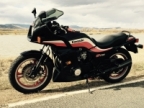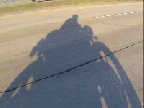- Posts: 23027
- Thank you received: 2758
CSR1000 Project Build
- SWest
-

- Offline
- Sustaining Member
- 10 22 2014
Steve
Please Log in or Create an account to join the conversation.
- davido
-
 Topic Author
Topic Author
- Offline
- User
- Posts: 1582
- Thank you received: 291
Brett,the cable should fit ,no problem at both ends. Everything is standard Kawasaki.Theres nothing to be adapted. Wrenchmonkey,I think
youre right in the fact that I will just put it all together and see what happens.Ive got too much other stuff on my plate to be messing around with this at the minute.I asked the question in the hope that others had maybe been through this and come up with a solution but it seems most people just go for an Acewell setup or something similar.
www.kzrider.com/forum/11-projects/594313-csr1000-project-build
CB550 (1978)
CB500/4 (1972)*
KZ1000CSR (1981)
XT 600E (1999)
TDM900 (2003)
Please Log in or Create an account to join the conversation.
- davido
-
 Topic Author
Topic Author
- Offline
- User
- Posts: 1582
- Thank you received: 291
www.tacomaworld.com/tirecalc?tires=82.5-82.5r19-120-70r17
And it seems that there will not be that much difference in the clock reading after all.No worries.Sorted.
So a great resource for others with the same question. Isnt it amazing what you can find on the interweb? Thanks to everyone for chipping in.
www.kzrider.com/forum/11-projects/594313-csr1000-project-build
CB550 (1978)
CB500/4 (1972)*
KZ1000CSR (1981)
XT 600E (1999)
TDM900 (2003)
Please Log in or Create an account to join the conversation.
- davido
-
 Topic Author
Topic Author
- Offline
- User
- Posts: 1582
- Thank you received: 291
So,the headlight works.....and thats about it. Everything flashes when I push the hazard lights switch,so the power is there and capable of reaching the lights .There are 2 flasher units ( indicators and hazard lights) 1 of which works some of the time,the other dosnt do anything..
Anyway,electrics arent my strong point,so Im trying to think of a logical approach to this and ,hopefully avoid melting my brain.
" New flasher units. Clean all the connections properly (the first clean was just the outside of everything to make it easier to work on).
If anyone has any advice it would be greatly appreciated. Some generic electrical faultfinding basics would be good.Specifically a logical order to attacking this. Thanks in advance.
www.kzrider.com/forum/11-projects/594313-csr1000-project-build
CB550 (1978)
CB500/4 (1972)*
KZ1000CSR (1981)
XT 600E (1999)
TDM900 (2003)
Please Log in or Create an account to join the conversation.
- Irish-Kawi
-

- Offline
- User
- Posts: 498
- Thank you received: 37
Best of luck man!
Brett
All the gear all the time!
1985 Kawasaki GPz 750 (ZX750-A3) 15,000 original miles www.kzrider.com/forum/11-projects/601230...z750-refresh-project
Father - Husband - Bourbonr - Rider
Please Log in or Create an account to join the conversation.
- davido
-
 Topic Author
Topic Author
- Offline
- User
- Posts: 1582
- Thank you received: 291
www.kzrider.com/forum/11-projects/594313-csr1000-project-build
CB550 (1978)
CB500/4 (1972)*
KZ1000CSR (1981)
XT 600E (1999)
TDM900 (2003)
Please Log in or Create an account to join the conversation.
- Irish-Kawi
-

- Offline
- User
- Posts: 498
- Thank you received: 37
davido wrote: Youre right Brett and thats what Ive been doing today. Happy to say Ive gotten a partial result. Headlight, clocklights, tail light,brake lights are all doing their thing.The problem is the indicators. I went to my local today for new flasher relays but he didnt have what I wanted,so I took a second hand 2 prong and a new 3 prong. Unknown quantities. I have constant light on both front indicators,regardless of switch position and nix on the back indicators.Then the kids came home,so that was it foer the day. So,still some figuring out to do but Ill get there in the end Im sure.
Sounds like some good progress and some answers are finally shaping up for ya, really glad to hear that
We both understand there are time constraints but it is a marathon and not a race, family is more important than any bike but it's also good to have a balance too, you're doing the right moves and making good headway each time you got this!
If there is something I can help with even if it's just chatting or bouncing ideas off of someone shoot me a PM and happy to chat or text etc.
Take care and keep at it David you got it
Brett
All the gear all the time!
1985 Kawasaki GPz 750 (ZX750-A3) 15,000 original miles www.kzrider.com/forum/11-projects/601230...z750-refresh-project
Father - Husband - Bourbonr - Rider
Please Log in or Create an account to join the conversation.
- wrenchmonkey
-

- Offline
- User
- Posts: 568
- Thank you received: 75
I was just looking through the wiring diagram in the Clymer manual as I saw that you had a pic of it earlier in the thread...
I arbitrarily picked page 332 - 1981-1982 KZ1000 M1 & M2, US & CDN models.
I don't know if this is a close match to your CSR or not?
However, It would appear normal that you are getting the front turn signal lamps to light-up when ignition is ON. The FRONT signal lamps are dual elements - 1=running lights, 2=turn signal light.
So I'd take this as a good sign (you said "lights on regardless of turn signal switch position).
What is happening then (ASSuming I'm not totally out in left field with model and year and such of your CSR) is you are just not getting any turn signal function. All else appears to be working properly.
So let's pick just the left turn signal light to test:
Put your meter on the Grey wire at the lamp - this is the turn signal wire - (the blue wire is the running light & black is the ground).
When you flip the turn switch to left turn, your meter should pulse or read 12vdc on intervals of the flasher.
Yes? - We're done here.
No? - Damnit Jim I'm a doctor! Not an electrical engineer! :laugh:
If the Grey wire doesn't pulse or show signs of voltage, then you could trace back through the turn switch (take it out of circuit and do a simple continuity test of the input terminal to the 2 output terminals) BUT my guess is it will trace back to the flasher unit.
The flasher unit is a 2-terminal flasher (not the 3 terminal kind). There, at the flasher, you will see and Orange wire that is connected to both flasher units (Hazard flasher is Orange & Red/Green, Turn flasher is Orange & ... Orange?). The orange wire going to BOTH flashers is the source wire for 12vdc input to the flasher and comes from a 10a fuse that is powered when the ignition key turns on. Thus, you should meter it (the orange wire common to both flashers) and see 12vdc...
Yes? - Crack open an ale mate! Ur done! AND, your flasher is bad or the wrong type or wired backwards (flip the wires on the terminals around apparently solves some of these problems per other threads here...)
No? - Refer to Bones' statement again
If you have no 12vdc on the orange wire shared by both flashers, then trace back to your fuse. The supply wire is orange all the way back to a 10a fuse that has a Red/Green wire input to it.
Assuming your fuse is good (meter check for continuity) then you check that R/G wire side for 12vdc.
Yes? - More Beer Please! Where's that infernal beer wench when you need'er?
No?
If no voltage present on that fuse's input wire (R/G), then trace it back to your ignition key switch. The R/G wire goes into a molex type connector and comes out as O/W to the actual ignition switch.
Meter both sides of that molex to see if you are getting 12vdc through the molex connector and or, output on the Orange/White wire from the key switch...
Hopefully, I'm even remotely close on your bike's model and year and these wire colours are accurate.
Fingers crossed.
Please Log in or Create an account to join the conversation.
- GPzMOD750
-

- Offline
- User
- Posts: 1365
- Thank you received: 148
Please Log in or Create an account to join the conversation.
- wrenchmonkey
-

- Offline
- User
- Posts: 568
- Thank you received: 75
The flasher unit has a specific input terminal - B or X or 49 - are the common labels that I've seen here in the USA.
This terminal must be where the source power is connected and not the load or lights.
The common label for a flasher's output terminal is - L or 49a -
So in the case of this project, those orange wires connected to both flashers must be connected to the terminal identified as "B" or "X" or "49".
You may be able to make use of that 3-terminal flasher in a pinch David.
Just ignore the terminal identified as "P" or "31". You should however, insulate/protect that terminal if you decide to use the 3 prong flasher. That 3rd terminal would typically be wired to the dashboard's signal light indicator bulbs in an automobile and outputs voltage just like terminal "L(oad)" does but at opposite cycles. Example - when "L" goes positive 12vdc, "P" is zero and when "L" goes zero then "P" will go positive 12vdc. Alternating the output.
Please Log in or Create an account to join the conversation.
- davido
-
 Topic Author
Topic Author
- Offline
- User
- Posts: 1582
- Thank you received: 291
Cant do anything with it today though as the table is covered in Lego. Im building a spaceship!!
It took me a while to find the right schematic. I went through the Clymer manual and,youre right,I think P332 is the closest but I went with the download in the KZRider filebase.
www.kzrider.com/filebase/download/94-kz1...000m1-wiring-diagram
Its in colour and looks nicer.I blew it up and printed it out .Im not sure if its the exact model but everything looks like what I have in real life.The only difference I can notice is that I have 3 brown wires coming out of the alternator and the schematic shows 3 yellow wires.Other than that ,it seems to match.
One of my problems here is that Im not familiar with the American system,so running lights are new to me (and useless,so Ill be ditching them) the other thing is having the headlight on permanently. I have a set of european switches with an on/off for the headlight,so I want to fit that into the loom eventually.Hazard lights are also new to me but I like the idea so I might keep them.
But first things first.To get everything working as is.What you say about the front indicators/running lights is good news. I didnt notice the double filament but it explains why there are 3 wires on the front indicators and only 2 on the back.
The flashers relays,I dont trust. Ill be getting a couple of new 2pin ones tomorrow.I know i can use the 3 pin but believe me I tried all combinations on both units,swapping pins and swapping units and got nothing. Ill fit the new ones (the right way round) and go from there.
If that dosnt do anything then Ill have to dig back into the wiring (following your guides).
Another thing Im curious about is,theres a diode right in the middle of the loom? Whats that all about?
www.kzrider.com/forum/11-projects/594313-csr1000-project-build
CB550 (1978)
CB500/4 (1972)*
KZ1000CSR (1981)
XT 600E (1999)
TDM900 (2003)
Please Log in or Create an account to join the conversation.
- wrenchmonkey
-

- Offline
- User
- Posts: 568
- Thank you received: 75
Yep. I know that table full of LEGO thing. I have a granddaughter who got this massive "Ariel's Undersea Castle" set for Christmas from her Nana which I think was a passive/aggressive move on her part, 'cause she knew who'd get stuck helping assemble a gazillion teeny parts together! :pinch:
You can test any of your flasher relays easily enough with just a spare piece of wire and any working rear signal lamp assembly:
Connect a spare wire from battery positive(+) terminal to flasher's "X" terminal.
Connect signal lamp's positive input wire to the flasher's "L(oad)" terminal.
Touch the signal lamp's ground wire to the battery negative(-) terminal.
Once you touch the ground wire to the battery, you will complete the circuit. The bulb in the signal lamp should flash. If it doesn't then your flasher is gone the way of the DoDo...
BTW. Older flasher units can usually be dismantled by prying open the tin can's tabs around the base where the terminals are and lift-off the tin can to expose the black magic guts. Typically, you'll find lots of oxidation dust and dirt. Blow the solenoid clean, especially at the electromagnet's top where it pulls down the arm (magnetically, when energized) and closes the contact to pass current through to the "L" terminal. Probably an 80% chance it will work just fine again (except of course if you're planning on using LED lighting).
Then again, for less than $2, you can replace it. Whatever is easier
Often, on the really old vehicles I restored, replacement flashers weren't an option so I had to repair them for originality's sake.
Please Log in or Create an account to join the conversation.
